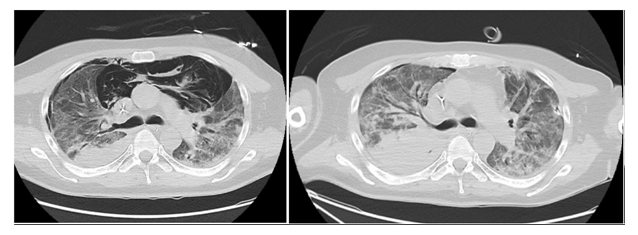Prone-Positioning as an Effective Treatment for Severe Pneumomediastinum in COVID-19 Patients. A Patient Series Cases
Alan Girardini, Alessandro Mancosu, Andrea Rizzolo, Fabiana Salici, Stefania Primavera, Nicola Petrucci*
Department of Anesthesia and Intensive Care, Desenzano Hospital, ASST del Garda. Loc. Montecroce 1 - 25015 Desenzano D/G, Brescia, Italy
*Corresponding Author: Nicola Petrucci, Department of Anesthesia and Intensive Care, Desenzano Hospital, ASST del Garda. Loc. Montecroce 1 - 25015 Desenzano D/G, Brescia, Italy.
Received: 16 November 2021; Accepted: 24 November 2021; Published: 30 November 2021
Article Information
Citation: Girardini A, Mancosu A, Rizzolo A, Salici F, Primavera S, Petrucci N. Prone-Positioning as an effective treatment for Severe Pneumomediastinum in COVID-19 patients. A Patient Series Cases. Anesthesia and Critical Care 3 (2021): 58-63.
View / Download Pdf Share at FacebookAbstract
Pneumomediastinum is a relatively frequent complication of COVID-19. It usually take up to 21 days to reabsorb and, in the critically ill, it could prolong time of mechanical ventilation and healing of the lung. In this case series, we present seven consecutive patients where Pneumomediastinum developed during non-invasive ventilation and was treated by prone positioning. Reabsorption was obtained in 48 hours in all the Cases.
Keywords
COVID-19, Pneumomediastinum, Prone positioning
COVID-19 articles; Pneumomediastinum articles; Prone positioning articles
COVID-19 articles COVID-19 Research articles COVID-19 review articles COVID-19 PubMed articles COVID-19 PubMed Central articles COVID-19 2023 articles COVID-19 2024 articles COVID-19 Scopus articles COVID-19 impact factor journals COVID-19 Scopus journals COVID-19 PubMed journals COVID-19 medical journals COVID-19 free journals COVID-19 best journals COVID-19 top journals COVID-19 free medical journals COVID-19 famous journals COVID-19 Google Scholar indexed journals Pneumomediastinum articles Pneumomediastinum Research articles Pneumomediastinum review articles Pneumomediastinum PubMed articles Pneumomediastinum PubMed Central articles Pneumomediastinum 2023 articles Pneumomediastinum 2024 articles Pneumomediastinum Scopus articles Pneumomediastinum impact factor journals Pneumomediastinum Scopus journals Pneumomediastinum PubMed journals Pneumomediastinum medical journals Pneumomediastinum free journals Pneumomediastinum best journals Pneumomediastinum top journals Pneumomediastinum free medical journals Pneumomediastinum famous journals Pneumomediastinum Google Scholar indexed journals Prone positioning articles Prone positioning Research articles Prone positioning review articles Prone positioning PubMed articles Prone positioning PubMed Central articles Prone positioning 2023 articles Prone positioning 2024 articles Prone positioning Scopus articles Prone positioning impact factor journals Prone positioning Scopus journals Prone positioning PubMed journals Prone positioning medical journals Prone positioning free journals Prone positioning best journals Prone positioning top journals Prone positioning free medical journals Prone positioning famous journals Prone positioning Google Scholar indexed journals High Dependency Unit articles High Dependency Unit Research articles High Dependency Unit review articles High Dependency Unit PubMed articles High Dependency Unit PubMed Central articles High Dependency Unit 2023 articles High Dependency Unit 2024 articles High Dependency Unit Scopus articles High Dependency Unit impact factor journals High Dependency Unit Scopus journals High Dependency Unit PubMed journals High Dependency Unit medical journals High Dependency Unit free journals High Dependency Unit best journals High Dependency Unit top journals High Dependency Unit free medical journals High Dependency Unit famous journals High Dependency Unit Google Scholar indexed journals Intensive Care Unit articles Intensive Care Unit Research articles Intensive Care Unit review articles Intensive Care Unit PubMed articles Intensive Care Unit PubMed Central articles Intensive Care Unit 2023 articles Intensive Care Unit 2024 articles Intensive Care Unit Scopus articles Intensive Care Unit impact factor journals Intensive Care Unit Scopus journals Intensive Care Unit PubMed journals Intensive Care Unit medical journals Intensive Care Unit free journals Intensive Care Unit best journals Intensive Care Unit top journals Intensive Care Unit free medical journals Intensive Care Unit famous journals Intensive Care Unit Google Scholar indexed journals CT scan articles CT scan Research articles CT scan review articles CT scan PubMed articles CT scan PubMed Central articles CT scan 2023 articles CT scan 2024 articles CT scan Scopus articles CT scan impact factor journals CT scan Scopus journals CT scan PubMed journals CT scan medical journals CT scan free journals CT scan best journals CT scan top journals CT scan free medical journals CT scan famous journals CT scan Google Scholar indexed journals
Article Details
1. Introduction
Pneumomediastinum (PNM) is defined as the presence of free air in the mediastinal cavity and could be associated with mechanical ventilation as a result of barotrauma. However, in COVID-19 patients, PNM has been described without mechanical ventilation in nearly 14% of patients, presumably due to extensive alveolar epithelial damage and pro-inflammatory cytokines (IL-6, IL-10), rather than mechanical ventilation itself [1]. Management of PNM is usually non-invasive, and spontaneous resolution is expected within 7 to 21 days [2], which could be a too much long time for a critically ill patient. Therefore, in massive PNM, needle aspiration or vacuum–assisted closure dressings to the supra-clavicular space may be adopted [2]. However, those manouvres are at risk of severe complications and mediastinitis.
2. Materials and Methods
Eighty-two COVID-19 patients with tracheal intubation were treated in our Intensive Care Unit (ICU) during the COVID-19 pandemic outbreak that occurred between November 2020 and April 2021 in Italy. In addition, more 23 patients were treated using CPAP or Non-Invasive Ventilation (NIV) in our High Dependency Unit (HDU). We present 7 consecutive patients where severe PNM occurred during CPAP or NIV, which is 30% of our total sample on CPAP/NIV. They all tested positive for SARS-COV-2 in nasopharyngeal swab. All patients had no identifiable risk factors for PNM complication (Table 1). They were admitted to Hospital after 7 day, on average, of fever, cough and fatigue, plus worsening dyspnea. Blood pressure was in normal ranges. At hospital admission in high-dependency unit, all patients were put on CPAP/NIV after oxygen supplementation by Ventimask 0.50 FiO2 failed to improve oxygenation. When used, NIV was started using PEEP range from 8 to 10 cm H2O. NIV mode is detailed in Table 1. Time to develop PNM, ranged from 3 to 13 days. Subcutaneous emphysema, increasing oxygen requirement and attempt to increase tidal volume despite ventilatory support, were the first signs of PNM, which was confirmed by CT imaging. One patient had a suspected minimal tracheal injury after 3 days of CPAP 10 cm H2O, which was not macroscopically visible via flexible bronchoscopy. Tracheal intubation and protective mechanical ventilation were started at the ICU admission, using TV of 5 to 6 ml/Kg/IBW on volume controlled ventilation, with plateau pressure less than 28 cm H2O and PEEP ranged from 2 to 10 cm H2O, according to driving pressure measurements. In the most severe PNM (Case 1) CT scan showed a massive PNM (25 cm transverse and 8.9 cm anterior-posterior) and pneumoperitoneum (Figure 1).
Thoracic surgical input was sought due to concerns over potential cardiac tamponade. However, we noted that during nursing manoeuvres, rolling left and right, the cardiac tone returned audible. Thus, we put the patient in prone position, obtaining a rapid resolution of PNM. All patients with PNM were pronated at ICU admission right after tracheal intubation. Duration of prone-positioning was variable, depending on improvement in oxygenation, ranging from 9 to 28 hours, in cycle of 18 or 24 hours each. None of the Cases were treated invasively for the PNM.
Table 1: Patients’ characteristics at time of PNM diagnosis, before tracheal intubation.

Figure 1: Chest scan showing massive Pneumomediastinum (25 cm transverse and 8.9 cm anterior - posterior) (left). After prone positioning the patient, CT scan at 48 hours showed the complete resolution of the PNM (right).
3. Results
We performed a CT scan after 48 hours which showed disappearance of PNM in all the Cases (Figure 1). No episode of mediastinitis occurred. Four patients died due to intractable hypoxemia, confirming data from recent literature showing high mortality rate in this group [3].
4. Discussion
In this Case series, PNM occurred in COVID-19 patients breathing in CPAP or NIV. CT analysis showed that ground-glass densities were primarily located subpleurally and along the lung fissures, explaining why PNM occurred in lungs with nearly normal compliance and low elastance [4]. All patients showed resolution of PNM at the CT scan control after 48 hours from pronation. The so called “Macklin effect” has been reported as the main mechanism sustaining the occurrence of the PNM [5]. This phenomenon describes the presence of a large pressure gradient between the marginal alveoli and the lung interstitial resulting in rupture of the wall, air leak to the surrounding bronchovascular sheath and interstitium, and migration toward the pulmonary hila, then into the mediastinum and eventually, because close proximity, into cervical region. If the subcutaneous tissue is insufficient to relieve the tension, the mediastinal parietal pleura may tear, resulting in concomitant pneumothorax [2]. In all the Cases reported in the literature PNM resolved with conservative management [6]. Prone positioning is an effective strategy for ARDS treatment, used in rates of 61% in COVID-19 patients, as well [7]. In our patients we noticed that, even after a single cycle of prone positioning, PNM disappeared at the chest CT scan performed after 48 hours. That is, much earlier than when was usually described in literature, and without the need of invasive procedures. Long lasting PNM might affect lung function in COVID-19 patients [8]. Therefore, its rapid resolution seems desirable. No complications occurred while proning the patients.
4.1 Why PNM resolved after prone-positioning
We hypothesized different mechanisms that could favor the absorption of PNM when patients are placed in prone position. First of all, PNM could be considered similar to a bubble of air and gases that is firstly mobilized and then squeezed during the pronation maneuver. In this position, the chest wall elastance increases, because of the limit opposed to the expansions of the ribs by the bed surface, as well as the heart and the diaphragm exert their weight on the anterior part of the mediastinum [9]. Therefore, the mass of air is compressed between stiff surfaces and probably is crashed into smaller bubbles, that could migrate through soft tissues where are adsorbed by vessels. In ARDS patients this squeeze is even stronger, because of the gravitational effect of the parenchymal edema that increases pulmonary weight [10]. In addition, the dorsal part of the lung, which accounts for about the 60% of the pulmonary mass, expands against the PNM, stretching its surface and promoting its mobilization. Lastly, pronation enhances oxygenation and relieves pulmonary hypoxic vasoconstriction, probably promoting the absorption of air. This case series suggests that pronation could favor the rapid resolution of PNM.
References
- Kahn MR, Watson RL, Thetford JT, et al. High incidence of barotrauma in patients with severe coronavirus disease 2019. J of Intensive Care 36 (2021): 1-9.
- Takada K, Matsumoto S, Hiramatsu T, et al. Spontaneous pneumomediastinum: an algorithm for diagnosis and management. There Adv Respir Dis 3 (2009): 301-307.
- Lyer VN, Joshi AY, Ryu JH, Spontaneous pneumomediastinum: analysis of 62 consecutive adult patients. Mayo Clinic Proc 84 (2009): 417-421.
- Gattinoni L, Chiumello D, Caironi P, et al. COVID-19 pneumonia: different respiratory treatments for different phenotypes? Intensive Care med 46 (2020): 1099-1102.
- Murayama S, Gibi S. Spontaneous pneumomediastinum and Macklin effect: overview and appearance on computed tomography. World J Radio 6 (2014): 850-854.
- Elhakim TS, Abdul HS, Pelaez Romero C, et al. Spontaneous pneumomediastinum, pneumothorax and subcutaneous emphysema in COVID 19 pneumonia: a rare case and literature review. BMJ Case Rep 12 (2020): e239489.
- Langer T, Brioni M, Guzzardella A, et al. Prone position in intubated, mechanically ventilated patients with COVID 19: a multi-centric study of more than 1000 patients. Crit Care 25 (2021): 128.
- Spagnolo P, balestro E, Alberti S, et al. Pulmonary fibrosis secondary to COVOD-19: a callto arms? Lancet Respir Med 8 (2020): 750-752.
- Guerin C, Albert RK, Beitler J, et al. Prone position in ARDS patients: why, when, how and for whom. Intensive Care Med 46 (2020): 2385-2396.
- Gattinoni L, Pesenti A. The concept of “baby lung” Intensive Care Med 31 (2005): 776-784.


 Impact Factor: * 3.1
Impact Factor: * 3.1 Acceptance Rate: 77.58%
Acceptance Rate: 77.58%  Time to first decision: 10.4 days
Time to first decision: 10.4 days  Time from article received to acceptance: 2-3 weeks
Time from article received to acceptance: 2-3 weeks 